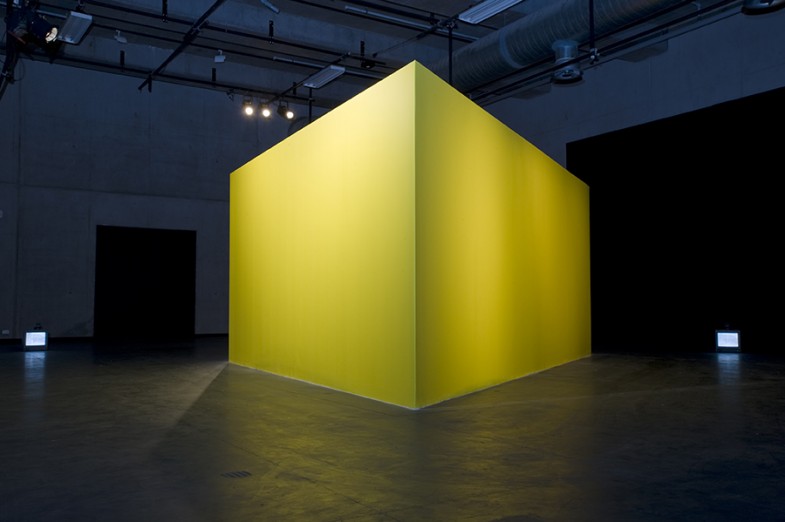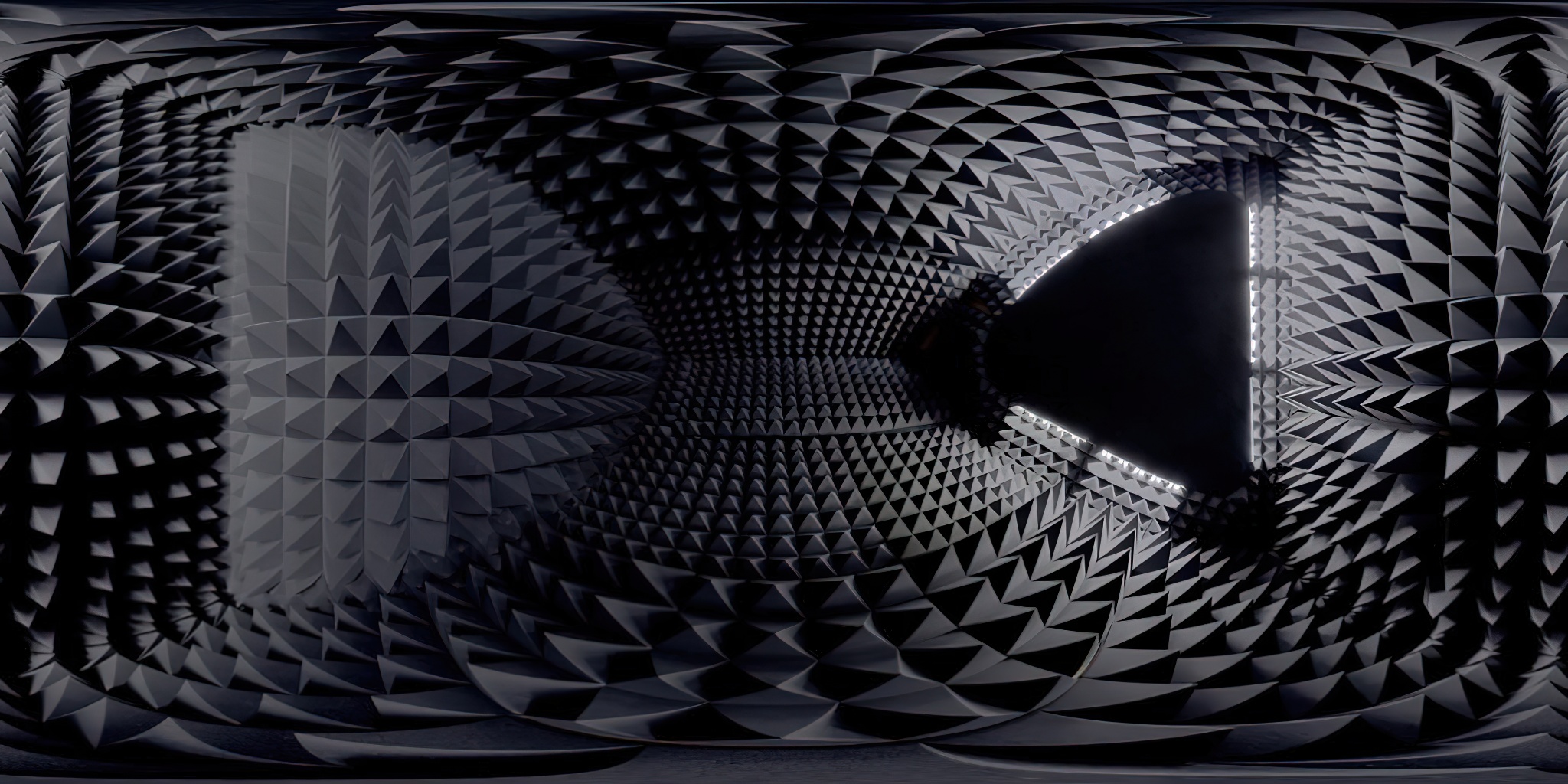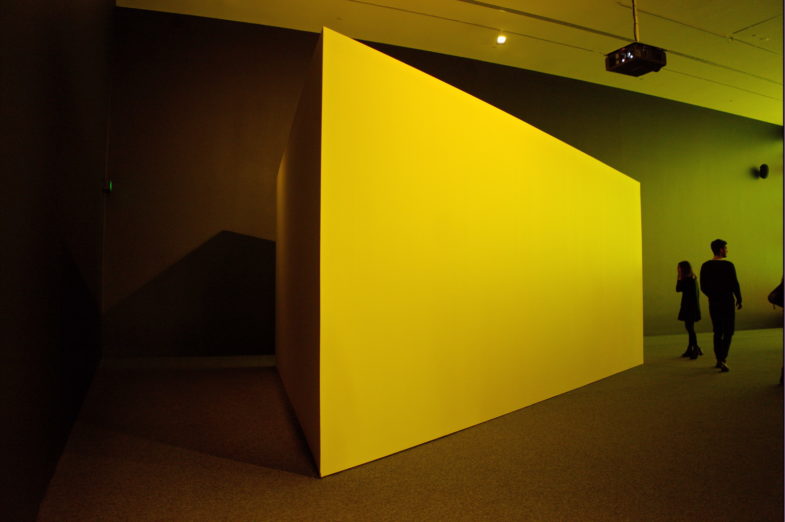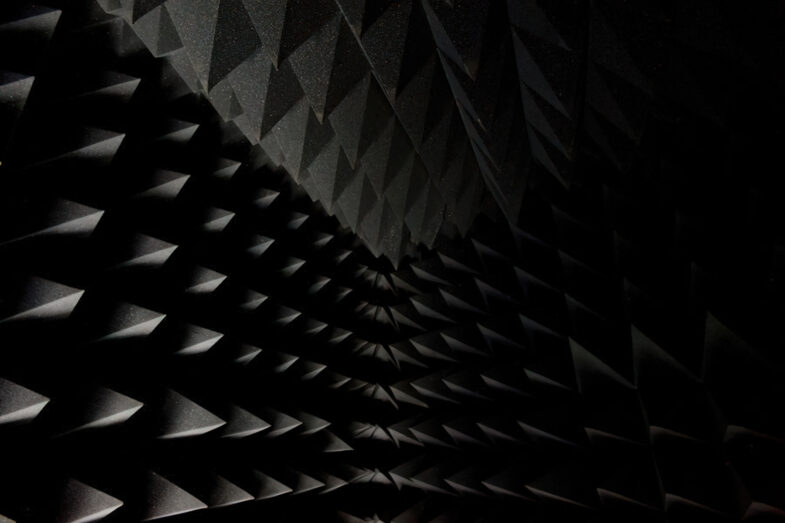Telepathy 2008, Performance Space. Telepathy 2016 MCA Sydney, Telepathy Muttuma 2021-Ongoing, Telepathy Guggenheim Gallery, Chapman University, Orange County, California, USA 2024

Telepathy (2008) was an installation commission by the collaborative team of David Haines and Joyce Hinterding. The commissioning process was initiated by Performance Space’s former Associate Director, Sally Breen, as part of a suite of new works by NSW-based artists, made specifically for the cavernous CarriageWorks environment and in relation to its history, former uses and present-day conversion. Haines and Hinterding responded to the visually layered, light-filled, busy and echoic building by considering a space for darkness, silence and solitude: an anechoic chamber. Though it is located at a nexus for Sydney’s railway network, surrounded by vibrations, speed and electricity, Telepathy is an environment created for the purpose of channelling energy inwardly, for slowing down and shutting out all other sounds aside from the voice and the mind of the self. It is a space for the individual, sheltered within a reverberant environment and a dazzling, high-chroma, monolithic object that houses a non-objective purpose and potential for experience. Performance Space acknowledges the continued support of the Visual Arts and Crafts Strategy, an initiative of the Australia Council, its arts funding and advisory body, and the New South Wales Government through ArtsNSW to make these commissioned works possible. Haines and Hinterding would like to acknowledge the skill of technician Steven Hamper in realising the structural integrity of the chamber.
Bec Dean Associate Director Performance Space

Telepathy interior view unfolded panorama. Photo Mike Myers
FALLING TO EARTH essay by Andrew Murphie
Although not obvious at first, Telepathy is also in many ways a personal work. Hinterding and Haines have been concerned with architecture—questioning structure—as never before during the past few years. For one thing, they have recently designed and built their own home in the Blue Mountains. The floor is wired as a house-sized radio antenna. So, telepathy is part of an ongoing exploration of the feeling/structure of “home”, the reverse polarity of the artist’s own home’s openness to the electromagnetic. Telepathy is also structured around a series of swerves towards/away from the artists’ influences. The ritual references the importance of Carlos Castaneda for Hinterding, and a stay at De Maria’s Lightning Field was crucial to her. The chamber itself arose from Haines’ interest in Roeg’s David Bowie film, The Man Who Fell to Earth, specifically a scene you see on the cover of Bowie’s album Station to Station—Bowie, the alien passing a threshold into an anechoic chamber. Then there are the references to Nauman’s colour, ritual, and uncompromising exploration of the body or to the difficulty minimalism faces in a world of maximum connection, activity, productivity, and mobility.
In Telepathy, minimalism has become combative. It requires a structure “that stops things”, one built “like a tank”, as Haines puts it. There is the gesture towards Cage’s famous experience in an anechoic chamber, towards Louise Bourgeois’ Red Room, or Ron Robertson-Swann’s Vault. Hinterding and Haines say that “hauntings of influence” crept up on them spontaneously during the planning and construction of the work. However, one wonders exactly who is haunting whom. Hinterding and Haines seem to inhabit all these influences and rewire them from the inside. The bright yellow of the prism, for example, seems tamed by the experience of the chamber within it. Undoing the uncanny Telepathy undoes influence in several directions as intensely as it acknowledges it. Doing so brings you to a place that feels like the inner heart of “home”. Yet, this is not an easy place to be. “Home” here also feels uncanny—“un-homelike”. It involves a return of the repressed, of origins as disruptive and disturbing within the familiar—that is, as upending a clear sense of my body, this space, the supposed safety of enclosure. The work demands courage, but with this, it promises much. Here, we can turn to artist and analyst Bracha Ettinger’s rewriting of the Oedipal, or, we might say more generally, the “anxiety of influence”. Ettinger insists that the uncanny can be as much about discovering repressed pleasure as repressed anxiety (The Matrixial Borderspace, Minnesota: University of Minnesota Press, 2006). The inside of the yellow prism is womb-like after all, insistently, almost aggressively so. Although, at the same time, in true Man Who Fell to Earth style, its hundreds of foam tentacles seem almost polysexual.
If every day, mediated experience is dominated by imaginaries that foster anxiety, in Telepathy, your body, your “own” thoughts, begin to step outside of this. It feels a little uneasy at first, to the point that even standing still feels awkward. Yet in the prism, there are hints of returning pleasures—of “subtle energies”, as Hinterding puts it. These can only re-emerge now that the bombardment of the senses, of the imaginary, and also of the more refined energetics of the body has been subdued. To block can be to re-energise. Telepathy undoes the anxiety of influence in part because it undoes much of what French thinker Bernard Stiegler sees as the profound intervention of media in the fundamental syntheses of experience. Telepathy’s cutting off from media flows allows for the structuring of experience that begins with a terminus—an end before you’ve started. You will have to start over again, more interestingly, even in the way little habits of body and movement are organized in heavily mediated cultures. Here, there is life in non-transmission, non-communication, and building as a medium that intensifies experience via a structure of subtraction. In a ritual space, shoes off, you pass through the first threshold into the gallery space. Three small televisions are on the floor—with little videos that nudge your consciousness at its fringes. They display low-res, fragmented images of a cottage on the site of Walter De Maria’s Lightning Field in the New Mexico desert. At first, however, they are probably passed by. There is a large, bright yellow triangular prism. You pass through the second threshold into the prism. The door is closed behind you. The chamber is anechoic, blocking sound and absorbing all resonance. Just as significantly in these days of iPhones and Blackberries, it blocks electromagnetic radiation. Mobiles won’t pick up a signal. Your body is still “unradiated” for the first time in ages. The space is uninterrupted by information. It’s a hot sweatbox—a direct physical space—at the same time as a highly technical and self-consciously architectural space. Hundreds of foam cones absorb sound and turn it into heat, allowing for an impossible return “home”: to a space of recovery, to one’s body, to every tiny sensation or impulse, to sounds and sensations, thoughts and feelings neither diluted nor distracted by an outside signal, communication, or even somewhere else to go. Yet the work is as open as it is closed. Who knows what people do, feel or think there or afterwards? The effect can be surprisingly subtle, perhaps something like—but not quite—the sacred. There is certainly a question—as open as it is specific for each person—of what influences us and how fundamentally. You perhaps re-emerge hesitantly from the chamber into the world. Or, is it that you return from the world, back into the imaginary experience of world that we take for everyday life? In fact, the two bleed into each other in the larger space, which now seems transformed. You are attuned to every subtlety in perception and structure.For David Haines and Joyce Hinterding, Telepathy is a very different work. It blocks energy where their other works gather it. They feel it’s more introverted, although this blockage also seems directly political in that it questions the constitution of subjective experience by influence.

Telepathy was also included in Energies: Haines and Hinterding 2016 MCA, Sydney.
STRUCTURE ITSELF
Telepathy—as sculpture—is finally an interrogation of the structure itself, of the literal if complex relations between building and experience, of organization in the most profound and intimate of senses. Freud’s description of the uncanny—and let’s be clear, Haines and Hinterding are resolutely anti-Oedipal—accounts for an ambivalence within the foundations of “home” that could apply to any consideration of structure. The uncanny arises from within that which seems most familiar because of the return of the repressed of “castration” upon which the bringing into being of the familiar is based. We can reframe this less Oedipally. “Home” can draw attention to one’s lack of power within the organisation or structure of the world, even and especially where one dwells. At home (perhaps in the middle of the night), unsettling feelings can arise. One sees more clearly that one is subject to powerful influences, deep within experience, that always come from elsewhere. In response, Telepathy’s intense questioning of home—of the relations between structure, influence and potential—marks the return of the body’s power, of its subtler energies. To experience Telepathy is to renew the experience of a different organization of thought, one found in dreams and in a courageous rethinking of the material structure itself as the basis for dreaming differently. It is only by stripping things back as far as Telepathy that we are forced to confront our own powers of reorganisation, the other powers with which they interact, and the way in which both mutually draw upon each other. This is the charm and the fear of constructing a space of silence and stillness, one in which to feel the chatter of the body as it communicates with itself or with the cosmos via something like Telepathy.

Telepathy MUTTAMA (in progress)
Commissioned by the Wired Lab in 2021, Telepathy Muttuma will become a permanent installation within a dedicated sound precinct in the Eastern Riverina Region in the small village of Muttuma in NSW. ” The Wired Lab is currently redeveloping the deconsecrated Church of the Immaculate Conception in Muttama, transforming it into a cultural destination that’s the first of its kind in the Southern Hemisphere. Once open and featuring a new decolonised name, ‘The Church’ will facilitate community activities and provide access to deep listening arts experiences by internationally renowned artists.”
‘THE CHURCH’ WILL FEATURE:
- A ‘Wiradyuri Yarning Circle’ at the heart of the site
- An ‘ambisonic’ sound array of commissioned listening experiences in the original nave
- ‘Telepathy’, a permanently installed, purpose-built anechoic chamber by David Haines and Joyce Hinterding
- A new adjoining build providing accommodation for resident artists and visitors.